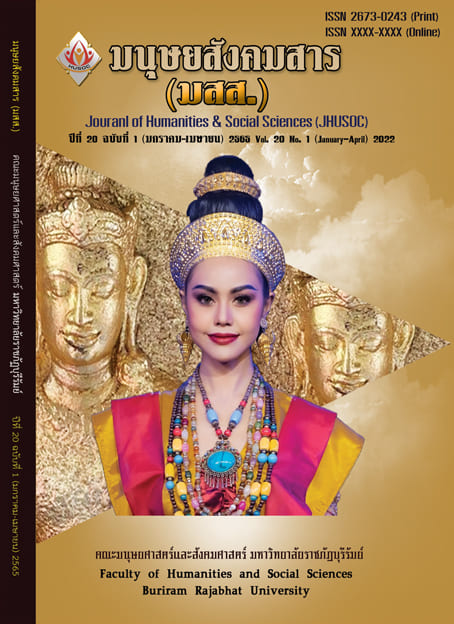ความสามารถในการปรับตัวของครัวเรือนชาวนารายย่อยในพื้นที่ชลประทานจังหวัดชัยนาท ต่อปัญหาความสามารถ ในการชำระหนี้ตามแนวทางเศรษฐกิจชุมชน
Main Article Content
บทคัดย่อ
การวิจัยศึกษาความสามารถในการชำระหนี้ของชาวนา เพื่อนำมาใช้สะท้อนความสามารถในการปรับตัวทางเศรษฐกิจของชาวนารายย่อย โดย ผู้ให้ข้อมูลสำคัญคือชาวนาหมู่บ้านนาชัย จำนวน 37 ครัวเรือน ในจังหวัดชัยนาท ใช้การวิจัยเชิงปริมาณ ประกอบการสัมภาษณ์ (In-Depth Interview) และการสังเกตแบบไม่มีส่วนร่วม (Non-Participant Observation) ผลการศึกษาพบว่า ชาวนาส่วนใหญ่ยังมีปัญหาหนี้สิน แต่มีแนวโน้มลดลง อย่างต่อเนื่อง แสดงถึงความสามารถในการชำระหนี้ที่ดีขึ้น การทำนาช่วงปี 2560/2561 พบว่ามีรายได้มากกว่าต้นทุน เมื่อนำมาวิเคราะห์กับแนวโน้มการมีหนี้สินลดลง แสดงว่ามีการบริหารจัดการหนี้สินดดีขึ้น เป็นไปตามแนวทางองค์กรการผลิตครัวเรือนชาวนา (เศรษฐกิจชุมชน) ครัวเรือนชาวนายังเลือกใช้แรงงานภายในครัวเรือนเป็นหลัก แต่เนื่องจากทำนาผืนใหญ่แรงงานไม่พอ จึงเสริมด้วยการจ้างแรงงาน การใช้แรงงานภายในครัวเรือนยังเป็นวิธีการทำนาที่มีสัดส่วนมากที่สุด แม้พบบางครัวเรือนใช้วิธีการจ้างทั้งหมดแต่มีสัดส่วนน้อย ทั้งนี้การใช้แรงงานในครัวเรือนไม่คิดเป็นมูลค่าในฐานะต้นทุนการผลิต ครัวเรือนชาวนาจึงยังทำการผลิตอยู่
Article Details

อนุญาตภายใต้เงื่อนไข Creative Commons Attribution-NonCommercial 4.0 International License.
เนื้อหาและข้อมูลในบทความที่ลงตีพิมพ์ในวารสารทดสอบระบบ ThaiJo2 ถือเป็นข้อคิดเห็นและความรับผิดชอบของผู้เขียนบทความโดยตรงซึ่งกองบรรณาธิการวารสาร ไม่จำเป็นต้องเห็นด้วย หรือร่วมรับผิดชอบใดๆ
บทความ ข้อมูล เนื้อหา รูปภาพ ฯลฯ ที่ได้รับการตีพิมพ์ในวารสารทดสอบระบบ ThaiJo2 ถือเป็นลิขสิทธิ์ของวารสารทดสอบระบบ ThaiJo2 หากบุคคลหรือหน่วยงานใดต้องการนำทั้งหมดหรือส่วนหนึ่งส่วนใดไปเผยแพร่ต่อหรือเพื่อกระทำการใดๆ จะต้องได้รับอนุญาตเป็นลายลักอักษรจากวารสารทดสอบระบบ ThaiJo2 ก่อนเท่านั้น
เอกสารอ้างอิง
Chimpali, C. (2021). The rice department has modeled a system for farming not more than 2 times a year to cope with drought. https://www.isranews.org/ content- page/item/27689-rice_ 27689.html [in Thai]
Daniel, T. (1966). Theory of peasants economy. Illinois: The American Economic Association. [in Thai]
Department of Cooperative Promotion. Capital Management Office. (2021). The Measures to reduce interest on production loans for rice farmers in the year 2014/15 production of cooperative members/farmer groups. https://www.cad.go.th/ [in Thai]
Hunt, E. K. (2003). Property and Prophets: The Evolution of Economic Institutions and Ideologies. New York: M. E. Sharpe.
Natsupha, C. (2007). The concept of community economy. Theoretical proposals in different social contexts. Bangkok: The Way of Life Foundation. [in Thai]
Natsupha, C. (2008). History of Thai economy. Bangkok: Chulalongkorn University Press. [in Thai]
Ngamlamom, W. (2021). Changing the way of life of farmers. http://file.siam2web.com/trdm/article/2013318_75343.pdf [in Thai]
Otasri, S. (2013). Existence of Thai peasants Occupation: A Case Study of Thai Peasants, Lopburi Province". Research and Development Journal Loei Rajabhat University, 8(25), 32-43. [in Thai]
Ouyyanont, P. (2003). Community economy of villages in the central region. Bangkok: Institute of Methodology. [in Thai]
Poapongsakorn, N., Hengtrakul, J., Anuchitworawong, C., Inthawitak, C., Arayapong, A., Chantarasiri, U., Suwandisthakul, P., Puntakua, K., Sri-anan, N., Nanta, M., & Gremi, M. (2021). The project on farmers debt conditions and potential improvement approaches operation of funds under the supervision of the ministry of agriculture and cooperatives of Thailand office of agricultural economics. https://tdri.or.th/wp-content/uploads/2019/05/ภาวะหนี้สินเกษตรกรFinal-Report.pdf [in Thai]
Thachin, P., Chaisupharakun, S., Ngampitiphan, T., Thongchua, S., & Chaimangkla, T. (2020). Sustainable debt reduction approaches by Ban Nachai community participation process. Chainat Province, [Master’s thesis]. Bangkok: Chandrakasem Rajabhat University. [in Thai]
Toadithep, T. (2013). Economic evolution of Pak Nam Prasae fishing community, [Master’s thesis]. Chonburi: Burapha University. [in Thai]
Viriyabanditkul, N. (2016). From traditional farmers to intelligent agribusiness entrepreneurs. http://www.dsdw2016.dsdw.go.th/doc_pr/ndc_2560-2561/PDF/8396e/8396น.ส.ณรินณ์ทิพ%20วิริยะบัณฑิตกุล.pdf [in Thai]


